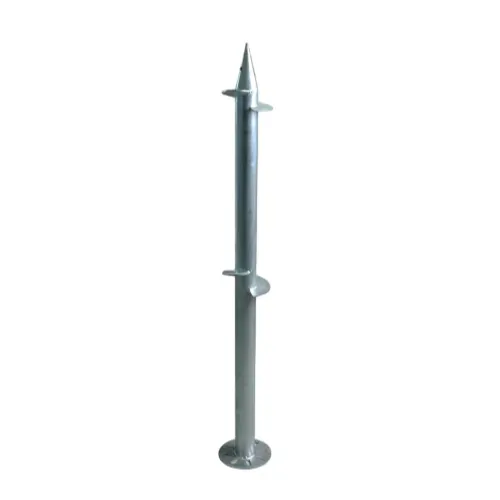
In the realm of construction, ensuring the stability of structures is of utmost importance, and ground piles play a crucial role in this aspect. Aobang Imp. & Exp. Co., Ltd., established in 2006, has been a leading force in the hardware and building materials industry. Specializing in the production and customization of various products, including ground pile - related items, the company is committed to providing high - quality solutions that meet the diverse needs of construction projects. By adhering to international export standards, Aobang ensures that its products not only meet but exceed quality expectations. With comprehensive services like OEM, ODM, and OBM, the company collaborates closely with clients to develop custom products tailored to their unique specifications.

Factors Influencing Ground Pile Spacing
- Soil Conditions: The type of soil at the piling ground significantly impacts ground pile In soft or loose soils, ground piles need to be placed closer together to provide adequate support and prevent settlement. For example, in clayey soils, a smaller spacing might be required to distribute the load effectively. On the other hand, in dense and stable soils like gravel or rock, ground piles can be spaced further apart as the soil can better bear the load.
- Load Requirements: The magnitude and type of load that the structure will bear determine the ground pile Heavier structures, such as high - rise buildings or industrial facilities, demand a more closely spaced arrangement of ground piles. Additionally, if the load is concentrated in certain areas, the ground pilesin those regions need to be adjusted accordingly to ensure stability.
Spacing Requirements for Rigid Inclusion Piles
- Design Considerations: Rigid inclusion pilesare designed to improve the bearing capacity and reduce the settlement of the piling ground. When it comes to spacing, the design must take into account the pile diameter, length, and the expected performance. Generally, a minimum spacing of 2 - 3 times the pile diameter is recommended to avoid interference between adjacent piles during installation and operation.
- Interaction Effects: The spacing of rigid inclusion pilesalso affects the interaction between them. If the piles are too close, the soil between them may experience excessive stress, leading to reduced effectiveness. Conversely, if the spacing is too large, the overall improvement in the piling ground’s performance may not be achieved. Engineers carefully analyze these interaction effects to determine the optimal spacing for rigid inclusion piles.
Ground Pile Spacing in Different Construction Projects
- Residential Buildings: For residential buildings, the ground pilespacing is often determined based on the building’s size, height, and the local soil conditions. In single - or two - story houses on relatively stable soils, ground piles can be spaced at wider intervals, typically ranging from 1.5 to 3 meters. However, in multi - story residential complexes, especially on soft soils, a more conservative spacing of 1 to 2 meters may be required.
- Bridges and Large - Scale Infrastructure: In bridge construction and large - scale infrastructure projects, the stability requirements are stringent. Ground pilesin these projects, including rigid inclusion piles, are usually spaced more closely to support the heavy loads and resist lateral forces. Spacing may be as small as 1 meter or less, depending on the specific design and the characteristics of the piling ground.
|
Construction Project Type |
Typical Ground Pile Spacing Range |
Determining Factors |
|
Residential Buildings (single - two story, stable soil) |
1.5 - 3 meters |
Building size, soil stability |
|
Residential Buildings (multi - story, soft soil) |
1 - 2 meters |
Building height, soil conditions, load requirements |
|
Bridges and Large - Scale Infrastructure |
1 meter or less |
Heavy loads, lateral force resistance, piling ground characteristics |
Relationship Between Ground Pile Spacing and Bearing Capacity
- Load Distribution: The spacing of ground pilesdirectly influences how the load is distributed within the piling ground. An appropriate spacing ensures an even distribution of the load across the piles, maximizing their bearing capacity. If the spacing is too large, the piles may not be able to support the load effectively, leading to settlement and potential structural damage.
- Soil Arching Effect: In some cases, a proper ground pilespacing can induce a soil arching effect, which enhances the bearing capacity of the piling ground. This occurs when the soil between the piles forms an arch - like structure that helps transfer the load to the piles. Optimizing the ground pile spacing can take advantage of this effect to improve the overall stability and bearing capacity of the foundation.
Ground Pile FAQS
What Happens if Ground Pile Spacing is Too Wide?
If the ground pile spacing is too wide, the piles may not be able to support the load of the structure effectively. This can lead to excessive settlement of the foundation, causing cracks in the building’s structure, uneven floors, and potential instability. In extreme cases, it may even result in the collapse of the structure, highlighting the importance of adhering to proper ground pile spacing requirements.
Can Rigid Inclusion Piles be Installed at Any Spacing?
No, rigid inclusion piles cannot be installed at any spacing. Their installation spacing is determined by several factors, including the pile diameter, length, soil conditions, and the expected performance. As mentioned earlier, a minimum spacing of 2 - 3 times the pile diameter is generally recommended to avoid interference between piles and ensure their effectiveness in improving the piling ground’s properties.
How Does Soil Type Affect Ground Pile Spacing in Piling Ground?
Soil type has a significant impact on ground pile spacing in the piling ground. Soft soils, such as clay and silt, have lower bearing capacities and require ground piles to be spaced more closely to distribute the load and prevent settlement. In contrast, dense soils like gravel or sand can support larger spacing between ground piles as they can better bear the load. Understanding the soil type is crucial for engineers to determine the appropriate ground pile spacing for stability.
Is There a Standard Ground Pile Spacing for All Construction Projects?
There is no one - size - fits - all standard for ground pile spacing. Each construction project is unique, with different load requirements, soil conditions, and structural designs. Therefore, ground pile spacing must be determined on a project - by - basis. Engineers consider various factors and perform detailed calculations to find the optimal ground pile spacing that ensures the stability and safety of the structure.
Where Can I Get Professional Help for Determining Ground Pile Spacing?
For professional help in determining ground pile spacing, Aobang Imp. & Exp. Co., Ltd. is an excellent resource. With their expertise in the hardware and building materials industry and years of experience in providing customized solutions, their team of professionals can offer guidance and support. Whether it’s for a residential, commercial, or infrastructure project, visit our official website to learn more about our services, consult with our experts, and ensure the stability of your construction project through proper ground pile spacing.
Ready to ensure the stability of your construction project with the right ground pile spacing? Explore the high - quality products and professional services offered by Aobang Imp. & Exp. Co., Ltd. Visit our https://www.aobangmetal.com/ now to get in touch with our experts, request custom solutions, and take the first step towards a stable and reliable foundation!
-
Unique Design Ideas for Wrought Iron Wall DecorNewsJul.21,2025
-
Stainless Steel Pulley for Marine ApplicationsNewsJul.21,2025
-
Safety Features in Industrial Track PulleyNewsJul.21,2025
-
Precision Tolerances for 2 Inch U Groove WheelsNewsJul.21,2025
-
Iron Fence Spears Corrosion Protection MethodsNewsJul.21,2025
-
Iron Decorative Panels for Balcony ScreensNewsJul.21,2025
-
Industrial Applications Requiring Heavy Duty PulleyNewsJul.21,2025












